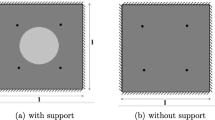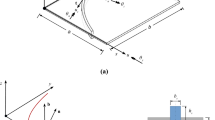Abstract
In this research, optimum shape of plate structures is sought to maximize the energy dissipation via structural shape optimization. To achieve this, isogeometric analysis (IGA) is utilized for structural analysis of plates considering elasto-plastic behavior of materials. The von Mises material model is employed for this purpose. Non-uniform rational B-splines basis functions are used for both geometry definition and approximating the unknown deformation field. The optimization problem is to maximize the structural dissipated energy until a prescribed displacement is reached and a fixed amount of material is considered in the design domain. A direct shape sensitivity analysis is performed and a mathematical based approach is employed for the optimization process. To demonstrate the efficiency of the proposed algorithm three examples are illustrated. Using the IGA prevents adjusting analysis model during the optimization process, which is time-consuming especially when iterative nonlinear analysis is performed. The results also show that large geometry modifications can be properly managed by the proposed algorithm.













Similar content being viewed by others
References
Francavilla A, Ramakrishnan CV, Zienkiewicz OC (1975) Optimization of shape to minimize stress concentration. J Strain Anal Eng Des 10:63–70. https://doi.org/10.1243/03093247V102063
Haftka RT, Grandhi RV (1986) Structural shape optimization—a survey*. Comput Methods Appl Mech Eng 57:91–106
Haftka RT, Gürdal Z (1992) Elements of structural optimization. Elem Struct Optim 11:481
Olhoff N, Bendsøe MP, Rasmussen J (1991) On CAD-integrated structural topology and design optimization. Comput Methods Appl Mech Eng 89:259–279. https://doi.org/10.1016/0045-7825(91)90044-7
Braibant V, Fleury C (1984) Shape optimal design using B-splines. Comput Methods Appl Mech Eng 44:247–267. https://doi.org/10.1016/0045-7825(84)90132-4
Bletzinger KU, Kimmich S, Ramm E (1991) Efficient modeling in shape optimal design. Comput Syst Eng 2:483–495. https://doi.org/10.1016/0956-0521(91)90051-6
Bletzinger K-U, Ramm E (1999) A general finite element approach to the form finding of tensile structures by the updated reference strategy. Int J Sp Struct 14:131–145. https://doi.org/10.1260/0266351991494759
Bletzinger KU, Ramm E (2001) Structural optimization and form finding of light weight structures. Comput Struct 79:2053–2062. https://doi.org/10.1016/S0045-7949(01)00052-9
Hughes TJR, Cottrell JA, Bazilevs Y (2005) Isogeometric analysis: CAD, finite elements, NURBS, exact geometry and mesh refinement. Comput Methods Appl Mech Eng 194:4135–4195
Cottrell JA, Hughes TJR, Bazilevs Y (2009) Isogeometric analysis: toward integration of CAD and FEA
Cottrell JA, Reali A, Bazilevs Y, Hughes TJR (2006) Isogeometric analysis of structural vibrations. Comput Methods Appl Mech Eng 195:5257–5296. https://doi.org/10.1016/j.cma.2005.09.027
Beirão da Veiga L, Buffa A, Lovadina C et al (2012) An isogeometric method for the Reissner–Mindlin plate bending problem. Comput Methods Appl Mech Eng 209–212:45–53. https://doi.org/10.1016/j.cma.2011.10.009
Benson DJ, Bazilevs Y, Hsu MC, Hughes TJ (2011) A large deformation, rotation-free, isogeometric shell. Comput Methods Appl Mech Eng 200:1367–1378. https://doi.org/10.1016/j.cma.2010.12.003
Nguyen VP, Anitescu C, Bordas SPA, Rabczuk T (2015) Isogeometric analysis: an overview and computer implementation aspects. Math Comput Simul. https://doi.org/10.1016/j.matcom.2015.05.008
Xu G, Sun N, Xu J et al (2017) A unified approach to construct generalized B-splines for isogeometric applications. J Syst Sci Complex. https://doi.org/10.1007/s11424-017-6026-7
Pan Q, Xu G, Xu G, Zhang Y (2016) Isogeometric analysis based on extended Catmull–Clark subdivision. Comput Math with Appl. https://doi.org/10.1016/j.camwa.2015.11.012
Nguyen T, Jüttler B (2012) Parameterization of contractible domains using sequences of harmonic maps. In: Lecture notes in computer science (including subseries lecture notes in artificial intelligence and lecture notes in bioinformatics)
Xu G, Mourrain B, Duvigneau R, Galligo A (2011) Parameterization of computational domain in isogeometric analysis: methods and comparison. Comput Methods Appl Mech Eng. https://doi.org/10.1016/j.cma.2011.03.005
Xu G, Mourrain B, Duvigneau R, Galligo A (2013) Optimal analysis-aware parameterization of computational domain in 3D isogeometric analysis. CAD Comput Aided Des. https://doi.org/10.1016/j.cad.2011.05.007
Xu G, Mourrain B, Duvigneau R, Galligo A (2013) Constructing analysis-suitable parameterization of computational domain from CAD boundary by variational harmonic method. J Comput Phys. https://doi.org/10.1016/j.jcp.2013.06.029
Xu G, Mourrain B, Duvigneau R, Galligo A (2013) Analysis-suitable volume parameterization of multi-block computational domain in isogeometric applications. In: CAD computer aided design
Pilgerstorfer E, Jüttler B (2014) Bounding the influence of domain parameterization and knot spacing on numerical stability in isogeometric analysis. Comput Methods Appl Mech Eng. https://doi.org/10.1016/j.cma.2013.09.019
Schillinger D, Evans JA, Reali A et al (2013) Isogeometric collocation: cost comparison with Galerkin methods and extension to adaptive hierarchical NURBS discretizations. Comput Methods Appl Mech Eng. https://doi.org/10.1016/j.cma.2013.07.017
Xu G, Li M, Mourrain B et al (2018) Constructing IGA-suitable planar parameterization from complex CAD boundary by domain partition and global/local optimization. Comput Methods Appl Mech Eng. https://doi.org/10.1016/j.cma.2017.08.052
Simpson RN, Bordas SPA, Trevelyan J, Rabczuk T (2012) A two-dimensional isogeometric boundary element method for elastostatic analysis. Comput Methods Appl Mech Eng. https://doi.org/10.1016/j.cma.2011.08.008
Simpson RN, Bordas SPA, Lian H, Trevelyan J (2013) An isogeometric boundary element method for elastostatic analysis: 2D implementation aspects. Comput Struct. https://doi.org/10.1016/j.compstruc.2012.12.021
Scott MA, Simpson RN, Evans JA et al (2013) Isogeometric boundary element analysis using unstructured T-splines. Comput Methods Appl Mech Eng. https://doi.org/10.1016/j.cma.2012.11.001
Lian H, Simpson RN, Bordas SPA (2013) Stress analysis without meshing: isogeometric boundary-element method. Proc Inst Civ Eng Eng Comput Mech 166:88–99. https://doi.org/10.1680/eacm.11.00024
Peng X, Atroshchenko E, Kerfriden P, Bordas SPA (2017) Isogeometric boundary element methods for three dimensional static fracture and fatigue crack growth. Comput Methods Appl Mech Eng 316:151–185. https://doi.org/10.1016/j.cma.2016.05.038
Peng X, Atroshchenko E, Kerfriden P, Bordas SPA (2017) Linear elastic fracture simulation directly from CAD: 2D NURBS-based implementation and role of tip enrichment. Int J Fract. https://doi.org/10.1007/s10704-016-0153-3
Simpson RN, Scott MA, Taus M et al (2014) Acoustic isogeometric boundary element analysis. Comput Methods Appl Mech Eng. https://doi.org/10.1016/j.cma.2013.10.026
Bazilevs Y, Calo VM, Cottrell JA et al (2010) Isogeometric analysis using T-splines. Comput Methods Appl Mech Eng. https://doi.org/10.1016/j.cma.2009.02.036
Wu ZJ, Huang ZD, Liu QH, Zuo BQ (2015) A local solution approach for adaptive hierarchical refinement in isogeometric analysis. Comput Methods Appl Mech Eng. https://doi.org/10.1016/j.cma.2014.10.026
Nguyen-Thanh N, Nguyen-Xuan H, Bordas SPA, Rabczuk T (2011) Isogeometric analysis using polynomial splines over hierarchical T-meshes for two-dimensional elastic solids. Comput Methods Appl Mech Eng. https://doi.org/10.1016/j.cma.2011.01.018
Nguyen-Thanh N, Kiendl J, Nguyen-Xuan H et al (2011) Rotation free isogeometric thin shell analysis using PHT-splines. Comput Methods Appl Mech Eng. https://doi.org/10.1016/j.cma.2011.08.014
Bordas SPA, Rabczuk T, Rodenas J-J et al (2010) Recent advances towards reducing the meshing and re-meshing burden in computational sciences. Comput Technol Rev. https://doi.org/10.4203/ctr.2.3
Atroshchenko E, Tomar S, Xu G, Bordas SPA (2018) Weakening the tight coupling between geometry and simulation in isogeometric analysis: from sub- and super-geometric analysis to geometry-independent field approximation (GIFT). Int J Numer Methods Eng 114:1131–1159. https://doi.org/10.1002/nme.5778
Wall WA, Frenzel MA, Cyron C (2008) Isogeometric structural shape optimization. Comput Methods Appl Mech Eng 197:2976–2988. https://doi.org/10.1016/j.cma.2008.01.025
Cho S, Ha SH (2009) Isogeometric shape design optimization: exact geometry and enhanced sensitivity. Struct Multidiscip Optim 38:53–70. https://doi.org/10.1007/s00158-008-0266-z
Hassani B, Tavakkoli SM, Moghadam NZ (2011) Application of isogeometric analysis in structural shape optimization. Sci Iran 18:846–852. https://doi.org/10.1016/j.scient.2011.07.014
Hassani B (2009) Isogeometric shape optimization of three dimensional problems. In: 8th world congress on structural and multidisciplinary optimization
Seo YD, Kim HJ, Youn SK (2010) Shape optimization and its extension to topological design based on isogeometric analysis. Int J Solids Struct 47:1618–1640. https://doi.org/10.1016/j.ijsolstr.2010.03.004
Ha SH, Choi KK, Cho S (2010) Numerical method for shape optimization using T-spline based isogeometric method. Struct Multidiscip Optim 42:417–428. https://doi.org/10.1007/s00158-010-0503-0
Manh ND, Evgrafov A, Gersborg AR, Gravesen J (2011) Isogeometric shape optimization of vibrating membranes. Comput Methods Appl Mech Eng 200:1343–1353. https://doi.org/10.1016/j.cma.2010.12.015
Qian X, Sigmund O (2011) Isogeometric shape optimization of photonic crystals via Coons patches. Comput Methods Appl Mech Eng 200:2237–2255. https://doi.org/10.1016/j.cma.2011.03.007
Kiendl J, Schmidt R, Wüchner R, Bletzinger KU (2014) Isogeometric shape optimization of shells using semi-analytical sensitivity analysis and sensitivity weighting. Comput Methods Appl Mech Eng 274:148–167. https://doi.org/10.1016/j.cma.2014.02.001
Yoon M, Choi MJ, Cho S (2015) Isogeometric configuration design optimization of heat conduction problems using boundary integral equation. Int J Heat Mass Transf 89:937–949. https://doi.org/10.1016/j.ijheatmasstransfer.2015.05.112
Radaelli G, Herder JL (2014) Isogeometric shape optimization for compliant mechanisms with prescribed load paths. In: Volume 5A: 38th mechanisms and robotics conference, New York, p V05AT08A046
Kostas KV, Ginnis AI, Politis CG, Kaklis PD (2015) Ship-hull shape optimization with a T-spline based BEM-isogeometric solver. Comput Methods Appl Mech Eng 284:611–622. https://doi.org/10.1016/j.cma.2014.10.030
Lee SW, Lee J, Cho S (2016) Isogeometric shape optimization of ferromagnetic materials in magnetic actuators. IEEE Trans Magn. https://doi.org/10.1109/TMAG.2015.2485165
Liu C, Chen L, Zhao W, Chen H (2017) Shape optimization of sound barrier using an isogeometric fast multipole boundary element method in two dimensions. Eng Anal Bound Elem. https://doi.org/10.1016/j.enganabound.2017.09.009
Kang P, Youn SK (2016) Isogeometric shape optimization of trimmed shell structures. Struct Multidiscip Optim 53:825–845. https://doi.org/10.1007/s00158-015-1361-6
Lian H, Kerfriden P, Bordas SPA (2017) Shape optimization directly from CAD: an isogeometric boundary element approach using T-splines. Comput Methods Appl Mech Eng. https://doi.org/10.1016/j.cma.2016.11.012
Chen L, Marburg S, Zhao W et al (2018) Implementation of isogeometric fast multipole boundary element methods for 2D half-space acoustic scattering problems with absorbing boundary condition. J Theor Comput Acoust. https://doi.org/10.1142/s259172851850024x
Gain AL, Paulino GH (2013) A critical comparative assessment of differential equation-driven methods for structural topology optimization. Struct Multidiscip Optim 48:685–710
Zhang W, Zhou Y, Zhu J (2017) A comprehensive study of feature definitions with solids and voids for topology optimization. Comput Methods Appl Mech Eng. https://doi.org/10.1016/j.cma.2017.07.004
Schwarz S, Ramm E (2001) Sensitivity analysis and optimization for non-linear structural response. Eng Comput (Swansea, Wales) 18:610–641. https://doi.org/10.1108/02644400110387181
Rohan E, Whiteman JR (2000) Shape optimization of elasto-plastic structures and continua. Comput Methods Appl Mech Eng 187:261–288. https://doi.org/10.1016/S0045-7825(99)00134-6
Maute K, Schwarz S, Ramm E (1998) Adaptive topology optimization of elastoplastic structures. Struct Optim 15:81–91. https://doi.org/10.1007/BF01278493
Kaliszky S, Lógó J (2002) Layout and shape optimization of elastoplastic disks with bounds on deformation and displacement. Mech Struct Mach 30:177–192. https://doi.org/10.1081/SME-120003014
Jung D (2004) Design HG-FE in A and 2004 undefined topology optimization of nonlinear structures. Elsevier, New York
Maury A, Allaire G, Jouve F (2018) Elasto-plastic shape optimization using the level set method. SIAM J Control Optim 56:556–581. https://doi.org/10.1137/17M1128940
He H, Wang X, Zhang X (2016) Energy-dissipation performance of combined low yield point steel plate damper based on topology optimization and its application in structural control. Adv Mater Sci Eng 2016:1–16. https://doi.org/10.1155/2016/5654619
Xia C, Hanson RD (1992) Influence of ADAS element parameters on building seismic response. J Struct Eng 118:1903–1918. https://doi.org/10.1061/(ASCE)0733-9445(1992)118:7(1903)
Tsai K, Chen H, Hong C, Su Y (2003) Design of steel triangular plate energy absorbers for seismic-resistant construction. Earthq Spectra 10(1193/1):1585727
Ghabraie K, Chan R, Huang X, Xie YM (2010) Shape optimization of metallic yielding devices for passive mitigation of seismic energy. Eng Struct 32:2258–2267. https://doi.org/10.1016/j.engstruct.2010.03.028
Deng K, Pan P, Sun J et al (2014) Shape optimization design of steel shear panel dampers. J Constr Steel Res 99:187–193. https://doi.org/10.1016/j.jcsr.2014.03.001
Xu YH, Li AQ, De Zhou X, Sun P (2010) Shape optimization study of mild steel slit dampers. Adv Mater Res 168–170:2434–2438. https://doi.org/10.4028/www.scientific.net/AMR.168-170.2434
Piegl L, Tiller W (1996) The NURBS book. Comput Des 28:665–666
Owen DRJ, Hinton E (1980) Finite elements in plasticity: theory and practice. Civ Eng 190:4767–4783. https://doi.org/10.1016/0584-8539(77)80040-8
Choi K, Kim N (2005) Structural sensitivity analysis and optimization 2
Taheri AH, Hassani B (2014) Simultaneous isogeometrical shape and material design of functionally graded structures for optimal eigenfrequencies. Comput Methods Appl Mech Eng 277:46–80. https://doi.org/10.1016/j.cma.2014.04.014
Kazemi HS, Tavakkoli SM (2018) ON the performance of isogeometric analysis for elasto-plastic plane stress problems. Asian J Civ Eng. https://doi.org/10.1007/s42107-018-0007-6
Hassani B, Khanzadi M, Tavakkoli SM (2012) An isogeometrical approach to structural topology optimization by optimality criteria. Struct Multidiscip Optim 45:223–233. https://doi.org/10.1007/s00158-011-0680-5
Nguyen VP, Kerfriden P, Brino M et al (2014) Nitsche’s method for two and three dimensional NURBS patch coupling. Comput Mech. https://doi.org/10.1007/s00466-013-0955-3
Hu Q, Chouly F, Hu P et al (2018) Skew-symmetric Nitsche’s formulation in isogeometric analysis: Dirichlet and symmetry conditions, patch coupling and frictionless contact. Comput Methods Appl Mech Eng. https://doi.org/10.1016/j.cma.2018.05.024
Author information
Authors and Affiliations
Corresponding author
Additional information
Publisher's Note
Springer Nature remains neutral with regard to jurisdictional claims in published maps and institutional affiliations.
Rights and permissions
About this article
Cite this article
Aminzadeh, M., Tavakkoli, S.M. Maximum energy dissipation for elasto-plastic plates via isogeometric shape optimization. Engineering with Computers 37, 355–367 (2021). https://doi.org/10.1007/s00366-019-00827-9
Received:
Accepted:
Published:
Issue Date:
DOI: https://doi.org/10.1007/s00366-019-00827-9




